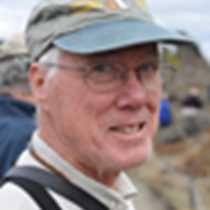Near Isla Carmen & Isla Santa Catalina, Baja California
All things, great and small. We departed La Paz, capital city of the Mexican state of Baja California Sur, and made our way northward during the night, unsure of what we would find. We didn’t have to "find"; the wildlife found us. Even before breakfast a group of bottlenose dolphins visited the ship to take a free ride on the pressure wave that is created as our bow cuts through the water of the Gulf of California. That turned out to be just a preamble. Soon we spotted spouts off in the distance. Tall spouts. We were in the presence of blue whales – the largest animal alive, the largest animal known to have ever lived. Some animals from the Eastern North Pacific population of blue whales enter the Gulf of California in winter, a few to bear and nurse their calves, others to harvest the rich productivity of Gulf waters. We watched three blue whales make repeated dives in search of swarms of krill. When a swarm is found the whales open their huge mouths (everything about a blue whale is huge, except its dorsal fin!) to engulf an enormous amount (about a bus-full) of water that is then expelled and the krill are trapped on the whales’ baleen plates. Within the life span of most of us (during the 1960s and 70s) blue whales of this population were heavily exploited by Russian factory-ship whalers in the North Pacific. The magnitude of their harvest has only recently been revealed. Fortunately, there are signs of a population recovery. We can only hope.
We took a brief break from the blue whales to enjoy the frenetic activities of a group of several hundred common dolphins. They were busy feeding – advancing as a line until a school of fish was located, and then milling with much acrobatic leaping as they harvested their prey. We then moved on to Isla Santa Catalina. This is the most isolated island of the Gulf of California. As a result, it has a high degree of endemism – plant and animal species and subspecies that are found only on this island. These include the giant barrel cactus and the Santa Catalina rattleless rattlesnake. Beyond the barrel cactus, there seems to be a high degree of gigantism in plants growing here. Huge cardon cactus dominated the hillsides, showing the first signs of the coming flowering season. Most of the desert plants seemed to be waiting for the next rainfall to burst into flower, but the floor of the arroyo up which we walked was carpeted with magenta desert lupines and small yellow daisies – annual plants that gave a welcome splash of color to the desert. The desert annuals (small and quick) and the giant cardon cactus (huge and slow growing) offer an interesting contrast in the adaptations of life to the deserts of Baja California.
All things, great and small. We departed La Paz, capital city of the Mexican state of Baja California Sur, and made our way northward during the night, unsure of what we would find. We didn’t have to "find"; the wildlife found us. Even before breakfast a group of bottlenose dolphins visited the ship to take a free ride on the pressure wave that is created as our bow cuts through the water of the Gulf of California. That turned out to be just a preamble. Soon we spotted spouts off in the distance. Tall spouts. We were in the presence of blue whales – the largest animal alive, the largest animal known to have ever lived. Some animals from the Eastern North Pacific population of blue whales enter the Gulf of California in winter, a few to bear and nurse their calves, others to harvest the rich productivity of Gulf waters. We watched three blue whales make repeated dives in search of swarms of krill. When a swarm is found the whales open their huge mouths (everything about a blue whale is huge, except its dorsal fin!) to engulf an enormous amount (about a bus-full) of water that is then expelled and the krill are trapped on the whales’ baleen plates. Within the life span of most of us (during the 1960s and 70s) blue whales of this population were heavily exploited by Russian factory-ship whalers in the North Pacific. The magnitude of their harvest has only recently been revealed. Fortunately, there are signs of a population recovery. We can only hope.
We took a brief break from the blue whales to enjoy the frenetic activities of a group of several hundred common dolphins. They were busy feeding – advancing as a line until a school of fish was located, and then milling with much acrobatic leaping as they harvested their prey. We then moved on to Isla Santa Catalina. This is the most isolated island of the Gulf of California. As a result, it has a high degree of endemism – plant and animal species and subspecies that are found only on this island. These include the giant barrel cactus and the Santa Catalina rattleless rattlesnake. Beyond the barrel cactus, there seems to be a high degree of gigantism in plants growing here. Huge cardon cactus dominated the hillsides, showing the first signs of the coming flowering season. Most of the desert plants seemed to be waiting for the next rainfall to burst into flower, but the floor of the arroyo up which we walked was carpeted with magenta desert lupines and small yellow daisies – annual plants that gave a welcome splash of color to the desert. The desert annuals (small and quick) and the giant cardon cactus (huge and slow growing) offer an interesting contrast in the adaptations of life to the deserts of Baja California.




